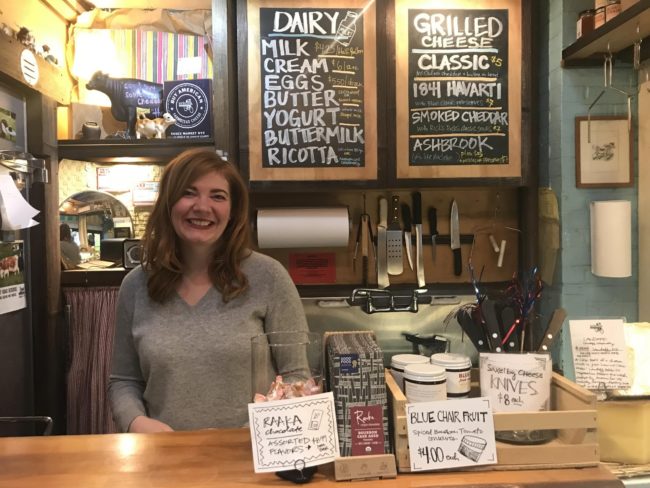Creating a good-looking cheese plate might seem hard to do, especially for cheese newbies. But Lauren Mossness teaches us how to make it fun and simple.
Mossness found her calling in the cheese world while working at a small shop in Montana. Now, she is the manager of Saxelby’s Cheesemongers at the Essex Street Market, in lower Manhattan.
Saxelby’s specializes in American cheese, which is why Mossness loves working there. But her favorite part of the job is creating cheese plates.

Saxelby’s at Essex Street Market
Cheese plates are generally comprised of four to six cheeses, fruit and crackers. Wine or cider is served as an accompaniment along with different types of bread. The cheese is served up on a wooden slab or an ornate plate. Lauren also likes to add nuts, fruit preserves and peppers to her plate.
There are endless ways to set up a cheese plate. Lauren helped answer a few questions that most readers have before they throw their first ever cheese party.
If you were making a cheese plate, how would you display it?
I really like to get a wedge of cheese and cut it up into tiny dainty triangles. I also mix it up with some different cuts of meat. It’s also fun to jazz it up with some crackers to give the plate a crunchy looking texture. I love adding fruit, especially for a pop of color.
Does adding dried fruits and nuts enhance the flavor of the cheese?
Yes! They can pick up on the different aspects of cheese. For instance, if a cheese has a medicinal cherry note, pairing it with apricots would cut through the medicinal taste and enhance the fruitiness. Olives work as a palette cleanser so its great to add that to your cheese plate. They’re also bright and stand out. My personal favorite is Castelvetrano olives.
What is the biggest mistake people make when it comes to making cheese plates?
Definitely when people forget to cut up their cheese. A giant wedge of cheese overpowers the plate. It also makes it difficult for guests to approach the cheese.
How do you decide which cheese to add to your plate?
For cheese plates, I always add a cow’s milk, goat’s milk and sheep’s milk cheese. So I would do one of each or two of each. I also add a mixed milk cheese to shake things up a bit. One of my go-to cheeses is Douda Gouda. It’s a hundred percent sheep’s milk cheese and it tastes like mac and cheese making it popular with everyone!
Do you have a favorite cheese that you’d always put on your cheese plate?
Yes! It’s the Oma from Jasper Hill made by the Von Trapp family. I love it because it’s perfectly balanced, organic and made from cow’s milk. The Sound of Music is also my favorite movie! The cheese has a washed rind which is done in order to prevent mold and bacteria. The rind gives the cheese a sharp nutty taste, only unique to such cheeses.
Do you serve the rind?
It depends on the cheese. Gnarly, thick rind is practically inedible. It’s like chewing on dirt. On the other hand, I love eating the rind on wash rind cheeses. Sometimes the rind to paste ratio is so great that you’d be wasting so much cheese if you didn’t eat the rind.
How do you decide which wine works best for which cheese?
When people come to Saxelby’s they usually have a wine picked out. Sometimes they come in blind and I recommend them a wine based on the cheese. For example, hard cow’s milk cheese goes well with red. Goat’s milk cheese pairs with Rosé. Smokey cheese goes well with Chardonnay. The oak in the Chardonnay really brings out the smokiness of the cheese!
Any other tips for our readers who want to throw a cheese party?
Always aim for room temperature cheese. It gives the best aroma and flavor. I’m also not afraid to add cheap cheddar to the plate! It’s popular for a reason because everyone loves eating it.
